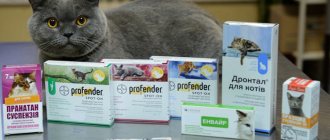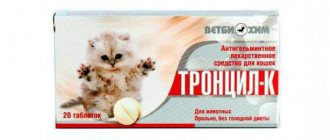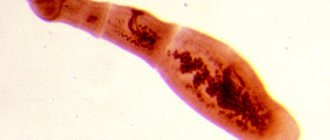Worms in dogs are a widespread disease from which no pet is immune. Helminthiasis is the scientific name for the pathology; it can occur suddenly and not manifest itself for years. All this time, irreparable harm is caused to the animal’s body, and the dog is a source of danger both for other pets and for people. In our article we will look in detail at what worms there are, possible methods of infection, how to find out if your pet is infected, how to remove parasites and how to protect yourself and your children from infection.
Methods of infection
The danger of the disease lies in the fact that parasite eggs are everywhere: in the water, in the ground, on the grass, in the sand. They get there along with animal excrement. Worm larvae mature at a temperature of 12-13°C and are not at all afraid of frost. Not a single dog, even the most well-groomed one, is completely immune from the threat of infection - this can happen to every pet.
Main methods of infection:
- Street dirt. A dog can pick up worms by drinking from a puddle or pond, licking street dirt from its fur, or picking up something on the street. At home, animals become infected with helminths through the owner's dirty shoes.
- In the womb or while breastfeeding. Puppies of dogs infected with heartworms can become infected directly in the womb or while breastfeeding. This is why it is so important to deworm pregnant animals.
- Parasitic insects. Fleas are carriers of flatworm eggs.
Types of helminths
Main types of parasites:
- Cestodes.
- Nematodes.
- Trematodes.
Tapeworms (cestodes)
Flat tape parasites develop in the dog's intestines. They attach themselves to the intestinal walls with suction cups and damage its surface. Where the parasitic worm attaches, an ulcer forms. The parasite's offspring grow and develop rapidly. Some long worms can reach 8-9 meters. The dog's gastrointestinal tract becomes clogged with worms - this leads to exhaustion, and a sad outcome is possible.
Most often, infection occurs from fleas, lice, and lice. Parasitic insects ingest tapeworm eggs, which begin to mature inside them. Cestode larvae enter the pet's body along with an accidentally eaten flea. The dog's intestines are an ideal environment for the development and reproduction of the parasite. The danger of the disease is that it can be asymptomatic for several years. All this time the dog is contagious.
Symptoms of cestode infection:
- Loss of appetite.
- Depressed or excited state.
- Hypovitaminosis of vitamin B12.
- Signs of gastrointestinal dysfunction appear: vomiting, diarrhea, constipation.
- Pernicious anemia.
- Decreased skin elasticity.
- Chronic dermatitis.
- Nervous attacks.
- An excessively bloated abdomen against a background of general exhaustion of the animal.
Roundworms (nematodes)
Roundworms parasitize the tissues and organs of the dog, most often the gastrointestinal tract, cardiovascular system (heartworms) and lungs (lungworms) are susceptible to infection. Nematodes are the most common helminths. Parasites penetrate the brain and heart and can rupture the intestinal walls or clog it completely, causing obstruction. The disease is considered fatal. There are frequent cases of death from intestinal volvulus, necrosis and peritonitis.
Symptoms of nematode infection:
- Alternating constipation and diarrhea. Uncontrollable diarrhea, yellow stool with mucus and blood. Pieces of helminths or whole individuals are found in the feces.
- Vomit. The attacks are uncontrollable - the dog vomits worms.
- Increased appetite, while the dog is exhausted.
- The dog rubs its anus on the floor, continuously reaching for its tail with its teeth.
- Food perversions - the dog eats soil, chews boards.
- Dermatitis and allergic reactions.
- Developmental delays in young animals.
- A swollen belly against the background of general exhaustion of the puppies.
- Sudden severe cough.
Flukes (trematodes)
Trematodes are parasites that are localized in the liver and bile ducts of dogs. Infection of a pet occurs through water, raw fish or seafood. The parasite attaches itself to internal organs with its suction cups. Mature individuals reproduce quickly and reach sizes of 20 cm.
The danger of infection is that due to the activity of worms, the integrity of the bile ducts is disrupted, which complicates the natural outflow of bile and pancreatic secretions. As a result, dogs develop cirrhosis of the liver, jaundice and other inflammatory phenomena. A fatal outcome cannot be ruled out.
Symptoms of trematodosis:
- Depressed state.
- An enlarged liver can be felt by palpation.
- A series of diarrhea and constipation.
- Exhaustion.
- Jaundice.
- Uncontrollable vomiting.
- Labored breathing.
- Increased body temperature.
- Nervous attacks.
With all types of infection in dogs, a blurred clinical picture is observed. Parasites can multiply asymptomatically in the body of a beloved pet for a long time, which is why it is so important to get tested for worms and carry out timely antiparasitic treatment of the animal.
Diagnostics
All pet owners are concerned about the question - how to understand that a dog has worms? If your dog exhibits at least one of the above symptoms, you should immediately collect a fecal sample and take it for a stool test. Collection of samples is carried out with a disposable spatula or spoon. The collected material is placed in a plastic container with a tight lid.
The sample can be stored in the refrigerator for a while, but it is best to get it to the clinic as soon as possible. If necessary, the veterinarian may order a repeat stool sample collection. To exclude a “false negative” result, you will need to collect fecal samples for three consecutive days.
To make a diagnosis, the doctor will need to study the anamnesis: the animal’s habitat and habits, diet. Sometimes the owner can independently detect worms or parts of them in the pet’s feces - this should also be reported to the veterinarian.
Deworming medications for dogs
Treatment for internal parasites is carried out both after the diagnosis of helminthiasis and for prevention. Animals that are fed a natural diet are dewormed 4 times a year. For dogs that eat dry food, the frequency of treatment is 2 times a year.
Anthelmintic drugs are always given in the following cases:
- if vaccination is due;
- 14-15 days before mating;
- simultaneously with the prescription of drugs against external parasites.
Anti-worm medications are classified according to several criteria:
- operating principle;
- according to the active substance;
- release form;
- depending on the direction of action.
Classification by principle of action
- Drugs with a paralytic effect contain substances that affect the nervous system of worms, paralyzing it. This group includes: Pirantel, Albendazole, Praziquatel, etc.
- Medicines that have a destructive effect on the outer shell of the worm: “Lintex”, “Biltricide”.
- Preparations with substances that disrupt the metabolism of worms: “Naftamon”, “Mebendazole”, “Aminoacrichtin”.
Classification by directional action
- Cestodes. “Aminoacrichtin”, “Fenasal”, “Agrovetzaschita Azinox”, “Praziquantel”.
- Trematodes. "Praziquantel", "Chloxyl", "Azinox".
- Nematodes. “Agrovetzaschita Febtal”, “Pirantel”, “Drontal”, “Carbendatsim”, “Agrovetzaschita Dironet”, etc.
Classification by active substance
- Ethanolamine derivatives: “Difezil”, “Naftamon”, etc.
- Imidazothiazole derivatives: Levamisole.
- Benzimidazole derivatives: Medamine, Mebendazole.
- Salicylamine derivatives: “Devemint”, etc.
- Pyrazinoisoquinoline derivatives: Praziquantel.
Classification by release form
- Deworming tablets for dogs.
- Capsules are a hollow enteric shell with an active ingredient.
- Suspensions.
- Injections.
- Pastas.
- Solutions for internal use.
- Suppositories that are inserted into the anus.
Antihelminthic drugs should be used exactly as prescribed by the veterinarian, who will tell you which tablets are best.
How to give a dog a deworming tablet
For greater effectiveness of deworming, the following rules must be observed:
- You can buy drugs only in specialized pet pharmacies;
- follow the recommendations of the veterinarian;
- check the expiration date of the medicinal product;
- find out all the available contraindications and carefully study the instructions for the medicine;
- the type of helminths must be determined in the laboratory;
- the form of the drug (tablets, suspensions, injections, drops on the withers) must be chosen by the veterinarian;
- for the greatest effectiveness of treatment, a second dose is taken 2 weeks after the first dose of the drug;
- before giving medicine for worms, anti-parasitic flea treatment is carried out;
- drugs for helminths are very toxic, so it is advisable to use them only after laboratory tests;
- to reduce the toxic effects of drugs and protect the liver, hepatoprotectors are given (Hepatovet, Legafiton, Karsil, etc.);
- it is necessary to ensure that the animal eats the medicine completely;
- You cannot bathe your dog for 2 hours after applying the medicine to the withers.
Review of anthelmintic drugs
There are many dewormers for dogs. They can be either broad-spectrum for preventive treatment or targeted for getting rid of a specific type of parasite. It is recommended to select the drug based on the age and weight of the animal, as well as the recommendations of the veterinarian.
Anthelmintic drugs are produced in the form of tablets, drops, suppositories, suspensions and pastes. The release form does not play a key role when choosing a product. It is important that the owner is comfortable using it and accurately calculates the dose. For example, tablets and dragees are usually used for worming adults and large dogs. Dewormers for puppies and small breed dogs are often produced in the form of suspensions.
Here are the names of some anthelmintic drugs:
- Azipirin. The drug is intended for cats and dogs, available in tablets (1 tablet per 10 kg of weight). Destroys flat and round worms. The advantage is low toxicity. Therefore, it can be used for worming pregnant and lactating bitches. Azipirin can be given to puppies from the age of four weeks.
- Dehinel Plus. An anthelmintic that destroys round and tapeworms. Intended for dogs of large and medium breeds (1 tablet per 35 kg of weight). Suitable for deworming pregnant and lactating dogs in the second half of pregnancy. The drug can be given to puppies no earlier than 7 weeks.
- Prazitel. Has a wide spectrum of action against round and tapeworms. Available in the form of a suspension and tablets for puppies, small, medium and large breed dogs. The suspension comes with a special dispenser syringe. The drug is contraindicated in puppies under 2 weeks of age, pregnant and lactating bitches, as well as malnourished animals.
- Drontal plus. Taken at the rate of 1 tablet per 10 kg of animal weight. No pre-diet or laxative intake is required. As a preventative measure, it is recommended to use the drug once every 3 months, as well as 10 days before vaccination and 10 days before mating. This anthelmintic is contraindicated for puppies of small breeds, as well as dogs in the first 2/3 of pregnancy.
- Helmimax. The drug has three types of dosage: for dogs of small breeds (1 tablet per 2-4 kg of weight), medium (1 tablet per 5-10 kg of weight) and large breeds (1 tablet per 10-20 kg). The product is allowed to be taken by pregnant bitches, but no later than 3 weeks before giving birth. The chicken flavor makes the anthelmintic appetizing to the animal, but can provoke an allergic reaction.
Read Signs and treatment of ataxia in dogs: 3 types of disease
Some people prefer to remove parasites using folk remedies, for example, celandine, tansy infusion, pumpkin seeds, garlic, etc. Some of them not only do not have proven effectiveness, but can also be dangerous for the animal. If you are used to giving your dog decaris for worms, be sure to follow the dosage and take into account contraindications.
Prices for drugs for anthelmintic treatment of dogs
Russia
- Agrovet protection Alben S, 6 tablets, from 100 to 110 rubles;
- Milprazone, 2 tablets, from 297 to 315 rubles;
- Api-San Prazicide-suspension Plus, 10 ml, from 145 to 150 rubles;
- Novartis Milbemax, 2 tablets, from 530 to 540 rubles;
- Drontal (Bayer) plus, 1 tablet, RUB 332;
- Api-San Dirofen suspension – deworming remedy for dogs, 10 ml, 175 RUR;
- Helmintal, 10 ml, from 280 to 300 rubles;
- Cestal plus, 1 tablet, from 100 to 110 rubles;
- Api-San Prazicide-suspension Plus, 10 ml, from 149 to 155 rubles;
- Levamisole – anti-worm injection, 50 ml, from 50 to 75 rubles;
- Euracon Pharma Kanikquantel plus XL, 12 tablets, from 1750 to 1900 rubles.
Ukraine
- Advocate (Advocate), 1 pipette, from 350 to 370 UAH;
- Caniquantel Plus, 1 tablet, from 30 to 32 UAH;
- Procox – suspension, 7.5 ml, from 190 to 195 UAH;
- Profender (Profender), 1 tablet, from 45 to 47 UAH;
- Dironet, 6 tablets, from 99 to 105 UAH;
- Prazicide Suspension Plus (Api-San), 10 ml, from 49 to 50 UAH;
- Palladium GOLDEN DEFENCE, 1 pipette, 125 UAH;
- Milbemax, 2 tablets, from 109 to 110 UAH;
- Bioveta Kaniverm – for puppies, 1 tablet, from 28 to 29 UAH;
- Levamisole – for injection, 10 ml, from 7 to 9 UAH;
- Livisto Aniprazol (Aniprazol), 1 tablet, from 67 to 69 UAH.
Folk remedies for worms
These remedies are usually treated at home. The first thing you need to know about folk recipes is that they do not have proven effectiveness. The second thing that is important to remember is that many of the folk recipes can harm your pet.
Traditional medicine:
- Celandine. Traditional medicine positions this plant as the best remedy for worms. In fact, it is a very poisonous plant. Poisoning with celandine causes convulsions in animals. Possible death.
- Garlic. Garlic is toxic to dogs. Don't poison your pet.
- Onion. Onion juice is used in folk recipes. Onions are dangerous for worms, but they are even more dangerous for dogs.
- Sagebrush. Some recipes use alcohol tincture of wormwood - this is a very risky method. Alcohol is very toxic, and wormwood is a poisonous herb. It is difficult to predict how a dog’s body will react to such a dangerous mixture.
- Raw pumpkin seed. The only folk remedy that will not harm the dog. It is effective only against cestodes. If infected with other parasites, it is useless to feed the dog pumpkin seeds. Recommended dosage: 5 g. seeds per 4-5 kg of animal weight. The seeds are given in peeled and crushed form. The powder is mixed with sunflower oil or melted fat. To achieve the greatest effect, you need to give this remedy for at least 5 days in a row.
- Fennel and chamomile decoction. Traditional medicine suggests replacing water with this decoction. The problem is that the dog will not drink this liquid. This method is only suitable for humans.
- Tansy infusion. An aqueous infusion of this plant will not harm your dog, but its effectiveness has not been proven.
- Carrot. Carrot juice depresses the nervous system of worms, but it must be administered using an enema. Giving your dog this juice is not harmful, but it is useless - the carrot juice is digested in the stomach. Only freshly squeezed juice is used, heated to 37.5-38.5°C.
Remember that all folk remedies have no proven effectiveness:
- they were not tested on control groups;
- they have no known contraindications;
- their effectiveness has not been proven;
- Allergic reactions and individual intolerance are possible.
Don't forget about this when deciding what to give your dog: a remedy from a veterinary pharmacy or a folk one.
Contraindications for worming
Anti-worm medications are toxic, and their uncontrolled use can cause deterioration in the animal’s health. Deworming has a number of contraindications that must be taken into account. Deworming is contraindicated:
- sick, weak and exhausted animals;
- dogs after surgery;
- puppies up to 2 weeks;
- if the animal has external parasites: fleas, lice, ticks.
Read Removing the fifth toe from a puppy and an adult dog: 3 stages
Antihelmintics should be given with caution:
- pregnant and lactating dogs;
- animals with chronic diseases;
- animals prone to allergies.
Preventive actions
Worms pose the greatest danger to young animals - puppies infected with parasites can die in 2-3 weeks. Therefore, preventive measures should be started as early as possible, without waiting for symptoms. Don't reassure yourself that the litter is kept sterile - all puppies can become infected in the womb, through her milk or directly.
The first dose of anthelmintic drug is given to puppies at three weeks of age. When choosing a product, pay attention to what age it is intended for. Only special medications for puppies are suitable; this should be indicated in the annotation for the medication. Liquid forms are preferable, since tablets are difficult to divide by weight and are difficult for children to eat.
Before deworming, weigh yourself - do not exceed the recommended dose. Repeated administration of the same drug is carried out 10 days before the first vaccination. You should not exceed the recommended volumes and frequency of deworming - these drugs have a strong toxic effect on animals. Your veterinarian will tell you how often to treat worms.
It is also mandatory to give anthelmintic drugs to females and males before breeding. Lactating animals need to treat their nipples to prevent infection of the offspring. For preventive purposes, anthelmintic drugs are prescribed twice a year to dogs fed industrial food. For animals receiving natural food – 4 times a year.
Prevention Tips:
- Do not let your animal wander on its own. Always be nearby and watch him during a walk so that the dog cannot drink water from a puddle or open reservoir, or eat garbage and excrement of other animals.
- Take preventive measures against lice and fleas, which are carriers of internal parasite eggs. Along with taking medications for worms, give medications for external parasites.
- Don't give your dogs raw fish, especially freshwater fish.
How often should a dog be wormed?
Even if your pet lives in sterile conditions and you think that he does not have worms, it is still necessary to regularly worm your puppy and adult dog for preventive purposes.
First deworming
Worms can even appear in newborn puppies. They become infected from their mother, for example through the placenta or milk. Therefore, the first treatment is carried out 3-4 weeks after birth. It is important to use special preparations marked “for puppies”.
The second time worming of puppies should be carried out 10 days after the first dose of the drug. This is necessary in order to remove parasite decay products from the body.
Breaks in domestic dogs
Even if an animal does not leave the apartment, this does not mean that it cannot be infected. Insects - flies and cockroaches - can be carriers of parasite eggs. Also, dirt from the street can be brought into the house on shoes and clothes by the owner himself.
The frequency of preventive deworming depends on the age of the animals. It is recommended to deworm dogs under one year of age once every 3 months. In adult animals, preventive treatment is carried out once every six months.
The number of procedures should also depend on nutrition. If an animal eats natural food (raw meat, minced meat, offal and fresh fish), the risk of infection with parasites increases. Therefore, it is recommended to carry out treatment once every 3-4 months.
For preventive purposes, the animal is treated for worms once. But if parasitosis is suspected, the drug is given again 10-14 days after the first procedure. When deworming, the drug acts only on adult parasites. After 1.5-2 weeks, intact worm eggs mature and grow. They are destroyed with the second dose of the drug.
Signs of parasitosis for which repeated deworming is recommended:
- blood, mucus or adult forms of worms in the stool;
- bloating, characteristic rumbling;
- increased appetite accompanied by weight loss;
- diarrhea and vomiting;
- constipation;
- The dog rubs its anus on the floor, reaching for its tail with its teeth.
Important! If an animal is to be vaccinated, it must be dewormed 7-10 days before vaccination.
Read Signs and treatments for vitamin deficiency in dogs: 9 vitamins your dog is missing
How to give drugs to street pets
Animals that live or spend a lot of time outdoors are much more likely to become infected with worms. A dog can pick up worms, for example, by picking up something from the ground, drinking water from a puddle, or by contact with other animals. In this case, it is recommended to give the drug against worms 3-4 times a year.
Deworming for pregnant and lactating women
Deworming is contraindicated in pregnant and lactating dogs. This can negatively affect the health of the puppies. This is especially worth considering in the first half of pregnancy, when all systems and organs are formed in puppies, and any negative intervention can lead to the development of pathologies. It can also cause a miscarriage.
Attention! It is better to worry about getting rid of parasites in advance and worm the dog 1.5-2 weeks before mating. But during estrus it is not recommended to do this.
It is not always possible for the owner to rid the pet of worms before mating. What to do in this case? On the one hand, deworming during pregnancy is dangerous, and on the other hand, parasites can also negatively affect the development of the fetus.
The best option is to use a product that is not contraindicated for pregnant and lactating animals. It is recommended to worm a pregnant dog in the second half of its term, and it is best to do this under the supervision of a veterinarian. A nursing dog can be dewormed no earlier than 2-3 weeks after the birth of the puppies.
Are worms in dogs dangerous for humans?
The most important question that concerns pet owners is whether worms are transmitted from dogs to humans? Parents of young children are especially worried about this. No one wants to overshadow the joy of communicating with an animal by such an unpleasant and even dangerous moment. This question is often asked in the veterinarian's office.
The first thing to remember is that not all types of dog worms are dangerous to humans. Secondly, most parasites are not able to develop in an unnatural habitat. Third, parasites are transmitted from pets to humans through the fecal-oral route, that is, through the mouth. The eggs of sexually mature female worms are released in dog excrement. They can remain on the animal's fur or objects. Children and adults who do not maintain personal hygiene may accidentally ingest them.
What can a person get sick with?
- Echinococcosis. The disease is caused by the parasite Echinococcus granulosus, which lives in the small intestine of dogs. Children who have too close contact with pets are most susceptible to the disease. The helminth larva cannot develop inside a person; it migrates throughout the body and settles in the liver or lungs. A cyst forms around it and grows over several years. Symptoms of infection appear too late, when the cyst reaches a large size - this is an incessant cough, pain in the chest or abdomen, diarrhea, nausea and vomiting. Severe allergies and anaphylactic shock are signs of a violation of the integrity of the cyst.
- Toxocariasis. The causative agent is the helminth Toxocara canis. The parasite larvae are carried into the bloodstream throughout the body. They can settle in the eyes - ocular toxocariasis. In the lungs, liver and central nervous system - visceral toxocariasis. Complications depend on the form of the disease: loss of vision, pneumonia, cirrhosis of the liver.
- Alveococcosis. The causative agent is the tapeworm Echinococcus multilocularis. A very common disease that affects any internal organs. Patients lose weight and feel general weakness. In advanced cases, cirrhosis of the liver and inflammation of the biliary tract develop. Possible death.
- Coenurosis. The disease is caused by tapeworm larvae. Cysts - tsenura - form around the larvae. The clinic manifests itself in different ways. It all depends on where the cyst is located. In the spinal cord - paralysis of the lower limbs. Brain – migraine, weakness, loss of consciousness and convulsions. In the eyes – decreased and complete loss of vision. Cysts in the brain are a common cause of death.
- Dipylidiasis. The disease is caused by the tapeworm Dipylidium caninum. When the parasite penetrates the intestines, it grows into an adult. Symptoms: diarrhea, itching, rash, abdominal pain. In advanced cases, intestinal obstruction is possible.
All these dangerous diseases can be prevented by strictly observing the rules of personal hygiene and hygiene of pets: clean the dog’s area, wash your hands with soap after each contact with the animal and before eating, close children’s sandboxes with a lid, and do not allow children to play in dog-walking areas.
Principles of treatment of worms in dogs
The veterinarian should recommend an anthelmintic drug for the pet based on age. Many modern drugs are universal, low-toxic and well tolerated by animals.
You should purchase medications from veterinary pharmacies or special departments of pet stores. It is better to give puppies and small breed dogs not a tablet, but a suspension, pouring it in with a syringe. There are also drops for the withers, but they are not suitable for puppies, pregnant bitches and weakened animals. Basic principles of treatment:
- It is better to treat adult dogs of medium and large breeds with tablets, since the dosage is easy to calculate.
- The tablet should be given on an empty stomach. The dose is calculated based on body weight. The suspension is poured into the throat using a dispenser syringe. You can feed your pet two hours after taking the medicine.
- Treatment of dogs for worms will be effective if you use modern drugs, they are used once. Repeating is recommended after 2-3 weeks to destroy the grown larvae.
- The dosage of tablets for prevention is calculated by the veterinarian. Medicine against worms is given from three weeks of age, and tablets are given again every six months. It is important to rid your dog of fleas first. Deworming is carried out two weeks before vaccination.
- During the treatment period, the animal may feel unwell because the body is poisoned by toxins from dead parasites. To reduce the negative effect, during and after taking the tablet, give your pet a sorbent (activated carbon) and a hepatoprotective agent.
- If the animal does not show signs of infection and looks good, then it is better to limit itself to preventive measures (give a tablet once every six months).
- All animals living in the same area will need treatment for worms. Owners should also take an anthelmintic tablet.











